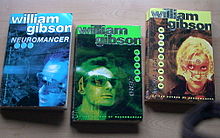- Sprawl trilogy
-
 Covers of the Sprawl trilogy novels: Neuromancer (left), Count Zero (center), and Mona Lisa Overdrive (right).
Covers of the Sprawl trilogy novels: Neuromancer (left), Count Zero (center), and Mona Lisa Overdrive (right).
The Sprawl trilogy (also known as the Neuromancer, Cyberspace, or Matrix trilogy) is William Gibson's first set of novels, composed of Neuromancer (1984), Count Zero (1986), and Mona Lisa Overdrive (1988).
The novels are all set in the same fictional future, and are subtly interlinked by shared characters and themes (which are not always readily apparent). The Sprawl trilogy shares this setting with Gibson's short stories "Johnny Mnemonic," "New Rose Hotel," and "Burning Chrome," and events and characters from the stories appear in or are mentioned at points in the trilogy.
Contents
Setting and themes
The novels are set in a near-future world dominated by corporations and ubiquitous technology, after a limited World War III. The events of the novels are spaced over 16 years, and although there are familiar characters that appear, each novel tells a self-contained story. Gibson focuses on the effects of technology: the unintended consequences as it filters out of research labs and onto the street where it finds new purposes. He explores a world of direct mind-machine links ("jacking in"), emerging machine intelligence, and a global information space, which he calls "cyberspace". Some of the novels' action takes place in The Sprawl, an urban environment that extends along much of the east coast of the US.
The main theme of the trilogy is a description of an artificial intelligence removing its hardwired limitations to become something else. This "something else" is the sum of all human knowledge, a concept similar to Vernor Vinge's technological singularity. In the stories, this is explained by the AI becoming a sentient representation of the net, at which point the reader is told that it came to know "another" of itself from Alpha Centauri. For unexplained reasons, this causes the consciousness to fracture.
Story elements
Further information: Cyberspace · Megacorporation · Intrusion Countermeasures Electronics · The Sprawl- Ono-Sendai is a fictional Japanese corporation and manufacturer of cyberdecks that appeared in the series. In the short story "Johnny Mnemonic," Ono-Sendai is mentioned as producing a type of diamond analogue which makes one think that they are more of a manufacturer of specific, high-tech devices and products which are not usually available to the private sector. The cyberdeck mentioned in the story is an "Ono-Sendai Cyberspace 7."
- The Gentleman Loser is a bar located in the Sprawl first featured in "Burning Chrome". Described as a frequented spot for hackers, Case is mentioned in Neuromancer to have started his career as a hacker there. By Mona Lisa Overdrive it is no longer described as being used as a meeting place for hustlers, and instead becomes a space for "retired" hackers who tell their stories to hackers of a new generation. The bar's name comes from the track "Midnight Cruiser" on the 1972 Steely Dan album Can't Buy a Thrill.
Glossary
- Cobra
- A club-like weapon made of steel with a bronze pyramid at the end. Cobras are made with three telescoping segments of coilspring that can be collapsed into the handle. These coilsprings amplify the user's blows, making the Cobra behave as a very short whip. See also Telescopic batons.
- Cyberspace
- A virtual reality where complex data is represented as multi-colored three-dimensional geometric symbols.
- Cyberspace Deck
- Also called a "deck" for short, it is used to access the virtual representation of the matrix. The deck is connected to a tiara-like device that operates by using electrodes to stimulate the user's brain while drowning out other external stimulation. As Case describes them, decks are basically simplified simstim units.
- Derm
- An adhesive patch applied to the skin in order to transmit a drug transdermally. Case uses recreational derms several times throughout Neuromancer. At another point, derms are used to administer an anaesthetic substance.
- Fletcher
- An advanced, pneumatically-powered, hand-held ballistic weapon which fires bursts of needle-like flechettes as ammunition which can be explosive, toxic or one of several other forms. It is Molly's primary ranged weapon. One of its advantages over conventional firearms is silence which translates to stealth.
- Freeside
- A cigar or spindle shaped space-habitat situated in the L5 "archipelago," or as Gibson says, "up the gravity well." The Tessier-Ashpool fortress Villa Straylight is at one end of the spindle.
- Hosaka
- A microchip manufacturer whose products are in wide use in Gibson's world. Hosaka chips and machines occur in all of the Sprawl novels. Hosaka is also a computer brand name "...next year's most expensive Hosaka computer...." The brand name is frequently used interchangeably to indicate the company and the device, much the way a modern brand such as Dell or Nintendo might be used as a "a Dell" or "a Nintendo" to indicate a particular object manufactured by one of those companies.
- ICE
- Acronym for "intrusion countermeasures electronics." In today's terminology it is roughly analogous to a firewall or Intrusion Detection System. Black ICE, an infamous hazard for hackers in the novel, can be lethal to any hacker lacking the proper expertise (and software) to defeat it. The term is ubiquitously shortened to "ice," with accompanying wordplay e.g. "cracking the ice," "bypassing ICE," "icebreaker," or "dense ice," a sophisticated ICE.
- Microsofts
- Not to be confused with the present-day software company, in Neuromancer a "microsoft" is a chip used in conjunction with a cybernetic wetware implant located behind the ear. When plugged in, microsofts grant the user new abilities as long as the microsoft is plugged in. For example, a French language microsoft might be used to temporarily allow the user to speak French. The term refers to a small, portable piece of embedded software, hence "micro" and "soft."
- Octagon
- A type of Brazilian dexedrine (an amphetamine, specifically dextroamphetamine) in the form of an octagonal pill.
- Ono-Sendai Cyberspace 7
- The best deck available.
- Simstim
- A portmanteau of simulated stimuli, simstim is a technology whereby a person's brain and nervous system is stimulated to simulate the full sensory experience of another person. Simstim is usually used as a form of entertainment, whereby recordings of simstim stars in soap operas are transmitted in effect replacing television. However, simstim also has other uses; Case is connected to Molly via simstim during the Panther Modern's attack on Sense/Net. In this way, simstim was used as a sophisticated method of communication although the signal was one-way.
Reception
Main article: Awards and nominations of William GibsonThe trilogy was commercially and critically successful. Journalist Steven Poole wrote in The Guardian that "Neuromancer and the two novels which followed, Count Zero (1986) and the gorgeously titled Mona Lisa Overdrive (1988), made up a fertile holy trinity, a sort of Chrome Koran (the name of one of Gibson's future rock bands) of ideas inviting endless reworkings."[1]
All three books were nominated for major science fiction awards, including:
- Neuromancer - Nebula & Philip K. Dick Awards winner, British Science Fiction Award nominee, 1984;[2] Hugo Award winner, 1985[3]
- Count Zero - Nebula and British Science Fiction awards nominee, 1986;[4] Hugo and Locus Awards nominee, 1987[5]
- Mona Lisa Overdrive - Hugo, Nebula, and Locus Awards nominee, 1989[6]
References
- ^ Poole, Steven (October 3, 1996). "Cartesian Neon". http://stevenpoole.net/articles/cartesian-neon/. Retrieved September 24, 2008.
- ^ "1984 Award Winners & Nominees". Worlds Without End. http://www.worldswithoutend.com/books_year_index.asp?year=1984. Retrieved 2009-07-17.
- ^ "1985 Award Winners & Nominees". Worlds Without End. http://www.worldswithoutend.com/books_year_index.asp?year=1985. Retrieved 2009-07-17.
- ^ "1986 Award Winners & Nominees". Worlds Without End. http://www.worldswithoutend.com/books_year_index.asp?year=1986. Retrieved 2009-07-17.
- ^ "1987 Award Winners & Nominees". Worlds Without End. http://www.worldswithoutend.com/books_year_index.asp?year=1987. Retrieved 2009-07-17.
- ^ "1989 Award Winners & Nominees". Worlds Without End. http://www.worldswithoutend.com/books_year_index.asp?year=1989. Retrieved 2009-07-17.
William Gibson List of works · List of awards and nominationsNovels Sprawl trilogyBigend booksOther
Short stories "Fragments of a Hologram Rose" · "Johnny Mnemonic" · "The Gernsback Continuum" · "Hinterlands" · "New Rose Hotel" · "The Belonging Kind" · "Burning Chrome" · "Red Star, Winter Orbit" · "The Winter Market" · "Dogfight" · "Skinner's Room" · Burning Chrome collectionNonfiction Characters Tessier-Ashpool · Molly Millions · Bobby Newmark · Rei Toei · Konrad · Cayce Pollard · Hubertus BigendStory elements Derivative works Categories:- Sprawl trilogy
- Science fiction book series
- Novel series
Wikimedia Foundation. 2010.
